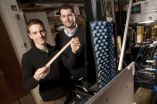(Press-News.org) DURHAM, N.C. – Duke University engineers have developed a novel sensor that is more efficient, versatile and cheaper for potential use in such applications as airport security scanners and collision avoidance systems for aircraft, cars or maritime vessels.
The researchers fabricated a unique material, known as a metamaterial, that acts as a lens to image scenes using fewer components than conventional detectors. Because of the properties of this man-made material, much of the additional equipment needed for conventional detector systems – like lenses, mechanical positioners and data storage or transmissions devices – are not required.
The material itself is a thin laminate with row-upon-row of tiny squares etched onto copper, each one of which is tuned to a different frequency of light. The material is flexible and durable enough to be attached to a wall, wrapped around corners or even laid on the floor like a rug, making it an inexpensive alternative for a variety of sensing applications.
The new system works with microwave light and produces two-dimensional images. The researchers are currently exploring moving the technology to three-dimensional capability in real-world settings.
The Duke researchers reported their findings Jan. 18 on-line in the journal Science. The research was supported by the Air Force Office of Scientific Research.
"By taking advantage of the unique properties of these metamaterials, we were able to create a system capable of microwave imaging without lenses or any moving parts, " said John Hunt, a graduate student working in the laboratory of senior investigator David R. Smith, William Bevan Professor of electrical and computer engineering at Duke's Pratt School of Engineering.
As an example, Hunt said that in many security situations, imaging systems move a single sensor device with a small aperture in front of the body of the subject, creating an effectively larger aperture. The scanning waves travel through clothing, but skin or other objects reflect the waves. The new device can scan the entire field at once, which would allow for faster and more efficient screening, the researchers said.
"Using conventional systems such as airport security cameras or collision-detection devices, you have to wait for a scan to complete before you can see an image, while the new system can scan an entire range at once," Hunt said.
The metamaterial is made of thousands of tiny apertures that can detect a wide spectrum of frequencies, allowing it to obtain a more global image of the scene, the researchers said.
"Each individual element of the metamaterial is tuned to narrow frequency," said Tom Driscoll, a post-doctoral fellow from the University of California – San Diego currently working in the Smith lab. "Together the individual elements scan the entire range to capture information about a scene very quickly."
"This system allows us to collect and compress the image during collection, instead of later, averting the detector, storage and transmission costs associated with conventional imaging of a scene," Driscoll said.
INFORMATION:
Other Duke members of the team were Alex Mrozack, Guy Lipworth, Matthew Reynolds and David Brady.
Novel sensor provides bigger picture
2013-01-18
ELSE PRESS RELEASES FROM THIS DATE:
Irregular heart beat elevates risk of kidney failure
2013-01-18
Many people who suffer from chronic kidney disease progressively lose their kidney function over time and eventually develop a condition called end-stage renal disease – the complete failure of the kidneys – placing them in need of lifelong dialysis or a kidney transplant.
Now researchers at the University of California, San Francisco (UCSF) and the Kaiser Permanente Northern California Division of Research have found that the risk of kidney failure is greater for people with chronic kidney disease who also have atrial fibrillation, one of the most common forms of irregular ...
Power's punishing impact
2013-01-18
Often, employees are shocked by what they think is a supervisor's severe reaction to a subordinate's seemingly minor transgression. The supervisors who punish them seem to be so absolutely sure that they are doing the right thing—they have a clear sense of purpose and there are no arguments to sway them.
New research by Scott Wiltermuth, a USC Marshall School of Business assistant professor of management and organization, and co-author Francis Flynn of the Stanford Graduate School of Business, found that providing a sense of power to someone instills a black-and-white ...
Mayo Clinic researchers identify enzyme involved in deadly brain tumors
2013-01-18
ROCHESTER, Minn. -- One of the most common types of brain tumors in adults, glioblastoma multiforme, is one of the most devastating. Even with recent advances in surgery, radiation and chemotherapy, the aggressive and invasive tumors become resistant to treatment, and median survival of patients is only about 15 months. In a study published in Neuro-Oncology, researchers at Mayo Clinic identify an important association between the naturally occurring enzyme Kallikrein 6, also known as KLK6, and the malignant tumors.
"Our study of Kallikrein 6 showed that higher levels ...
Botox beats steroids for painful foot condition, plantar fasciitis
2013-01-18
Los Angeles, CA (January 17, 2013) - Plantar fasciitis is the most frequent cause of chronic heel pain, leaving many sufferers unable to put their best foot forward for months at a time. Now a Mexican study suggests that physicians should turn to Botox rather than steroids to offer patients the fastest road to recovery. The research appears in the journal Foot & Ankle International, published by SAGE.
Plantar fasciitis results when connective tissues on the sole of the foot, the plantar fascia, become painfully inflamed. Physicians may suggest various therapies for this ...
Questions about biosafety? Ask a biosafety expert
2013-01-18
WASHINGTON— The rapid decline in costs associated with many common laboratory techniques, such as DNA sequencing and synthesis, has led to their adoption by individuals outside of traditional university or industrial settings, giving rise to a rapidly growing Do-It-Yourself Biology (DIYbio) community.
DIYbio.org and the Synthetic Biology Project at the Woodrow Wilson Center this week are launching the "Ask a Biosafety Expert" service in order to provide this emerging DIYbio community with free and timely access to professional biosafety advice. The project comes amidst ...
Why wolves are forever wild, but dogs can be tamed
2013-01-18
AMHERST, Mass. – Dogs and wolves are genetically so similar, it's been difficult for biologists to understand why wolves remain fiercely wild, while dogs can gladly become "man's best friend." Now, doctoral research by evolutionary biologist Kathryn Lord at the University of Massachusetts Amherst suggests the different behaviors are related to the animals' earliest sensory experiences and the critical period of socialization. Details appear in the current issue of Ethology.
Until now, little was known about sensory development in wolf pups, and assumptions were usually ...
Health and law expert: NFL not alone in handling concussions as 'benign' problems
2013-01-18
INDIANAPOLIS -- More than 2,000 former football players are suing the National Football League, saying the league should have taken action earlier to deal with injuries related to concussions more seriously.
But if a lack of speed in tackling concussions warrants criticism, the NFL isn't the only player deserving a penalty, according to a study co-authored by health care and law expert David Orentlicher, who teaches at Indiana University Robert H. McKinney School of Law in Indianapolis.
Neurologists were also slow in sounding the alarm, and for decades, concussions ...
New study challenges links between day care and behavioral issues
2013-01-18
CHESTNUT HILL, MA (Jan. 17, 2013) – A new study that looked at more than 75,000 children in day care in Norway found little evidence that the amount of time a child spends in child care leads to an increase in behavioral problems, according to researchers from the United States and Norway.
Several prior studies in the U.S. made connections between the time a child spends in day care and behavioral problems, but the results from Norway contradict those earlier findings, the researchers report in the online version of the journal Child Development.
"In Norway, we do not ...
Study findings have potential to prevent,reverse disabilities in children born prematurely
2013-01-18
PORTLAND, Ore. – Physician-scientists at Oregon Health & Science University Doernbecher Children's Hospital are challenging the way pediatric neurologists think about brain injury in the pre-term infant. In a study published online in the Jan. 16 issue of Science Translational Medicine, the OHSU Doernbecher researchers report for the first time that low blood and oxygen flow to the developing brain does not, as previously thought, cause an irreversible loss of brain cells, but rather disrupts the cells' ability to fully mature. This discovery opens up new avenues for potential ...
Want to ace that interview? Make sure your strongest competition is interviewed on a different day
2013-01-18
Whether an applicant receives a high or low score may have more to do with who else was interviewed that day than the overall strength of the applicant pool, according to new research published in Psychological Science, a journal of the Association for Psychological Science.
Drawing on previous research on the gambler fallacy, Uri Simonsohn of The Wharton School of the University of Pennsylvania and Francesca Gino of Harvard Business School hypothesized that admissions interviewers would have a difficult time seeing the forest for the trees. Instead of evaluating applicants ...




